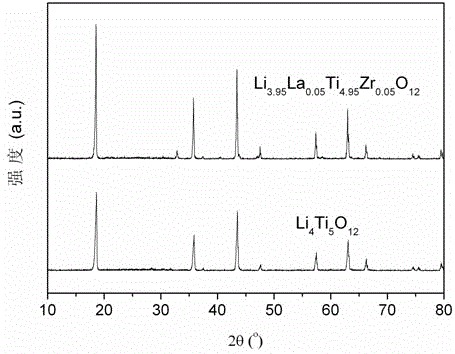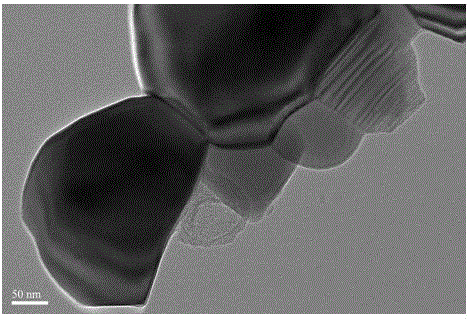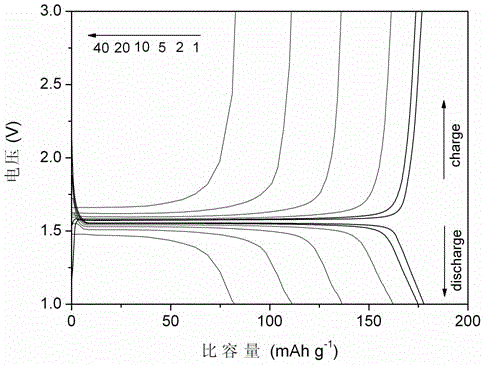Preparation method of lithium ion secondary battery with nanometer lithium titanate simultaneously doped at A and B site
A nano-lithium titanate and secondary battery technology, applied in battery electrodes, nanotechnology, nanotechnology, etc., can solve problems such as poor discharge performance at high rates, achieve improved bulk phase conductivity, good cycle stability, and improved The effect of mixing uniformity
- Summary
- Abstract
- Description
- Claims
- Application Information
AI Technical Summary
Problems solved by technology
Method used
Image
Examples
Embodiment 1
[0031] Firstly, 300 mL of ethanol and 30 mL of water were premixed according to the volume ratio of 1:0.1 to form a mixed solution, and then 15 mL of HNO 3As the inhibitor of follow-up reaction; Li and the compound of Ti, carry out batching according to the mol ratio of Li:Ti=4.2:5, take the tetra-n-butyl titanate (analytical pure) of 25.52 g, the lithium carbonate of 2.33 g ( analytically pure), added to the previous alcohol-water-acid mixture, stirred by a magnetic heating stirrer until completely dissolved; then added 0.3292 g of lanthanum nitrate and 0.257 g of zirconium nitrate, stirred, and dissolved; then 20 g of ethylenediaminetetra Add acetic acid and 30 g of citric acid to the premixed metal ion solution, mix well, add 100 mL of ammonia water dropwise to adjust the pH value to 8, and continue stirring; after the above mixed solution is stirred evenly to form a sol, heat and stir at 80 °C to the gel state, and then dried in a blast oven at 240°C to obtain a black and ...
Embodiment 2
[0033] According to the volume ratio of 1:0.1, 300 mL of ethanol and 30 mL of water were premixed to form a mixed solution, and then 15 mL of HCl was added as an inhibitor of the subsequent reaction; the compound of Li and Ti was mixed according to the molar ratio of Li:Ti=4.2:5 For batching, 21.31 g of tetraisopropyl titanate (analytical pure) and 6.43 g of lithium acetate (analytical pure) were weighed, added to the previous alcohol-water-acid mixture, and stirred by a magnetic heating stirrer until all Dissolve; then add 0.3292 g of lanthanum nitrate and 0.3321 g of neodymium nitrate, stir and dissolve; then add 20 g of ethylenediaminetetraacetic acid and 40 g of citric acid into the pre-mixed metal ion solution, mix well and add dropwise 100 Adjust the pH value to 9 with mL ammonia water, and continue to stir; after the above mixed solution is stirred evenly to form a sol, heat and stir at 80°C until it reaches a gel state, and then dry it in a blast oven at 240°C to obtain...
Embodiment 3
[0035] Premix 300 mL of ethanol and 60 mL of water according to the volume ratio of 1:0.2 to form a mixed solution, and then add 30 mL of HNO 3 As the inhibitor of follow-up reaction; Li and the compound of Ti, carry out batching according to the mol ratio of Li:Ti=4.4:5, take the tetra-n-butyl titanate (analytically pure) of 25.52 g, the lithium nitrate of 4.55 g ( analytically pure), added to the previous alcohol-water-acid mixture, stirred by a magnetic heating stirrer until completely dissolved; then added 0.3292 g of lanthanum nitrate and 0.3419 g of gadolinium nitrate, stirred and dissolved; then 20 g of ethylenediaminetetra Add acetic acid and 60 g of citric acid to the premixed metal ion solution, mix well, add 110 mL of ammonia water dropwise to adjust the pH to 7, and continue stirring; after the above mixed solution is stirred evenly to form a sol, heat and stir at 80°C to the gel state, and then dried in a blast oven at 240°C to obtain a black and fluffy lithium ti...
PUM
 Login to View More
Login to View More Abstract
Description
Claims
Application Information
 Login to View More
Login to View More - R&D
- Intellectual Property
- Life Sciences
- Materials
- Tech Scout
- Unparalleled Data Quality
- Higher Quality Content
- 60% Fewer Hallucinations
Browse by: Latest US Patents, China's latest patents, Technical Efficacy Thesaurus, Application Domain, Technology Topic, Popular Technical Reports.
© 2025 PatSnap. All rights reserved.Legal|Privacy policy|Modern Slavery Act Transparency Statement|Sitemap|About US| Contact US: help@patsnap.com



